Little Drummer Boy waiting at Home tintype

Click to Enlarge |
This is a small 2 inch, scratched tintype of a little drummer boy waiting at home for Daddy to return from Civil War. He wears a gray rendition of a shell jacket. Stands tapping a big drum. No ID yet known. The cute kids left behind....
Tintype with a Love Poem and a Lock of Hair
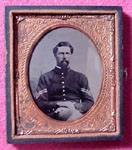
Click to Enlarge |
This is a 1/6th plate tintype of a young, Union corporal held in a half leatherette carrying case. Under the picture was found a lock of his sweetheart's hair sent as a momentoe along with a tender love poem, sent to give him faith and a manner of warm reflection: "Adieu, adieu... in that sweet parting kiss, I left my heart with thee..." Who knows how often under the roar of cannon and fierce musketry this man appraised these words of love waiting back home for him. Or had he sent it to her? We shall never know the exact details, but we can be sure that their bond was strong.
CDV of Soldier's Monument in Pittsfield, Mass.

Click to Enlarge |
Even monuments were placed upon the small calling-card sized paper-albumin images of the popular CDV during the Civil War. In one eerie case, a family photo album showed a tintype photograph of a proud young Union troop posing in his new uniform... while on the opposite side of the page, there was a somber CDV image of his white marble gravestone reading: Died of his wounds in a Confederate prison, aged 19 years."
Tintype of a proud Father and his Three Sons
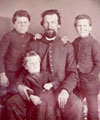
Click to Enlarge |
What a happy, proud father of three boys this Union private is!!! Look at the joy and good-nature in his warm face... This standard 1/6th plate tintype typifies the images taken by soldiers beside their loved ones before departing to war. Soldiers often carried images of wives, sweethearts and offspring throughout their campaigns. Sadly, many images were left gnarled on battlefields, never to be carried home again. Oftentimes, we find notes, messages, sprigs of flowers and locks of hair secreted within the letherette cases which house such old images. In this case, there is no such ID supplied~ we are simply left with this vision in time of a soldier-father happy over his children.
Autographed CDV of Joshua Lawrence Chamberlain
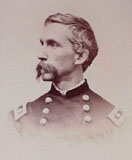
Click to Enlarge |
This is a Civil War-period CDV of Gen. Joshua L. Chamberlain, the Maine hero who led the 20th Maine Regiment in its glorious charge down Little Round Top on the second day of Gettysburg. He essentially made bold decisions which saved the Union Army at a critical moment, thus preventing a forced truce with the Confederates if they would have won at Gettysburg on that day. So in effect, many students of military history consider that Chamberlain's charge saved the Union. Often, family members and fellow soldiers requested autographed copies of CDV's for their albums. After the war, surviving members of regiments put-together entire books showing their comrads in unifoirm, sometimes with name as well as rank signed upon them in ink. This image was probably taken close to the end of the war. It is hand-signed in ink by Chamberlain himself, with a photographer's backmark of: Wm. Pierce, Photographer, Brunswick, ME. After the war, Chamberlain received the Congressional Medal of Honor for his actions at Gettysburg; was elected Governor of Maine; and served as President of Bowdoin College for decades. He returned with his men to Little Round Top in 1913 for the 50th Anniversary and died in 1914, some say from the very long-term complications of a bullet taken through his pelvis at Petersburg in 1864. His home in Maine is now kept a museum in his memory.
Ambrotype of Identified Pennsylvania Family
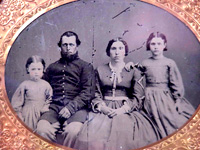
Click to Enlarge |
Based upon its dimensions, this is a "Half-Plate" Ambrotype, measuring-in at a big 5 1/2 inches x 4 1/2 inches. Therefore, the chemical emulsion is developed directly on a sheet of glass. It shows a stern-looking Union Private, Henry C. Conrad from Lanbury, PA, sitting beside his wife Anna, and daughters Mary & Marie, composing a great family portrait. As an ambrotype, it is superb in its composition, focus, and clarity, but sadly, the glass has cracked down the center over the years. This came with an original paper label giving us the sitters' names. Notice how the mother and girls all have the same genetic "lazy eye"... There were no braces, nose jobs or corrective eye surgey at this period in American history- you took what you got in life and succeeded based upon being an industrious and good person. In fact, many of these earlist photographs seem to show "stern" people. And yet, photographic exposure times required the sitters to remain completely still for 10-30 seconds or else they would blur. It was hard to hold a steady smile for that long, and therefore, the photographer usually advised people to look straight ahead without any dramatic facial antics. At times, the sitters' heads were held still by large cast iron frames or cradles put just behind them. Children were most prone to blurring from movement, but adults were not immune from being fidgety either...
AMAZING PHOTO SET: 3 CDV's and one Tin
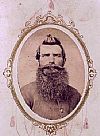
Click to Enlarge |
This image comes from a set of four pictures that show a wildly bearded soldier along with images of his wife. What an absolutely wild growth of facial hair! It seems to have a real mind of its own! Since we do not know his name, let's just call him Corporal Fuzzy Von Beardbuckett! That crazy waft of upright hair reminds me of the well-known comic Martin Short from his Saturday Night Live episodes or Cameron Diaz in that very funny flick "Something About Mary." This guy was either a real crabby codger or a really funny hoot! Definitely not a dullard either way!
Tintype of a Civil War Musician & Quartermaster
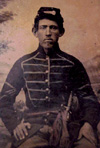
Click to Enlarge |
Tintypes were made in various sizes depending upon how much the customer wanted to spend. Prices often ranged from 10 cents to a dollar. The full tin plate was rarely ordered. Even half plates were a bit large. Thus, the 1/6th and 1/9th plates were the most popular for production in the Civil war and later periods. This image is the 1/6th plate, showing a Union quartermaster sergeant from the chevrons (stripes) on his upper arm. The intricate bands of contrasting cloth, called piping, across his chest were common to musicians. Each regiment had a band which consisted of drummers and fife players. They inspired the men on the march and entertained in camp. There were also specific cadences, or drum beats, which directed troops to march in a specific order. In a few cases, regiment bands were quite large and lavish when well-to-do officers endowed them with financial support. The government tried to stifle such excess but the soldiers still found ways around the regulations. Christmas and cultural holidays were often met with parties, balls and formal dinners. If the camp location was secure, the soldiers wives and families could attend. The bands were then employed to entertain while many of the soldiers often sang in groups. This musician also bears an 1840 Musician's Sword, as well as a faintly tinted red sword sash. When brass preserver (frame) removed, can see that the photographer's backdrop has tents and a US Flag.
Albany Zouave Ambrotype: 10th New York
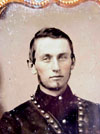
Click to Enlarge |
Look at those buttons!!!! This 1/9th plate ambrotype has superb clarity and contrast which demonstrates real soul in this handsome lad's face. That little beard rims his chin and comes up the center like a modern beatnik! His cheeks have a light pink tint. The uniform is great! The thermoplastic Union case carries "Peck's Patent" 1854. In pencil is written: Albany Zouave and 10th N.Y. In fact, certain companies of the NY 10th Zouaves were mustered from Troy, NY. The case is good except for some nicks and a crack at one hinge, but opens & closes fine. The ambrotype (naturally on glass) is perfect, but the back plate of contrast glass (painted black) which is required to "show" an ambrotype, is flaking. The two glass sheets are joined by an old process with balsam glue. At some point, a professional photographic restorer should split the glue, repaint the backing, and reseal it. I'm not trying that. This is a lovely picture of a young Zou!!!!!
Double-Armed Hardee Hat from Indiana
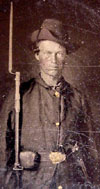
Click to Enlarge |
Ambrotypes developed on sheets of glass and tintypes fixed upon metal plates needed to be safely housed in order to prevent scratching of their photographic chemical emulsions. When exposed, digs, smudges and blatant lines were forever left upon the picture. Thus, images were sold in cases, sometimes of hard thermoplastic, but most often a faux leather pasted over a little wooden box which we call the leatherette case. The image plate was put under glass, but spaced from direct contact by use of a brass mat. The mat has with an oval, rectangular or scalloped opening to show the center of the image. A brass frame was then folded about the edges to hold the sandwich together. This assemblage was then set into the inside of the leatherette case. A lock of hair, note, poem or simple Identification in pencil was often included in the case behind the picture. Over the years, many cases split along their hinged seam, leaving the picture set in just the rear half of the case. We call this a "half-case". In this instance, the handsome Union private in a Hardee hat is still in a "full case". The mat bears bright patriotic motifs of flags, ships, cannon, and is marked "Constitution and Union". You can also see the velvet pad that fills the inside of the top cover. Rather than a typical Hardee plate, a strap holds up one side of this man's hat. His oval "US" belt and buttons are gold-gilted with paint, an accent effect performed by the photographer, since all pictures were black & white at the time. He holds his rifled musket with fixed-bayonet at attention. One can clearly see his cap box. Tucked in his belt is a shiny new Colt which is very clear. A faint pink watercolor tint has been added to his
cheeks while his trousers are accented in a light blue by the photgrapher.
CDV of New York surgeon with 1840 Medical Sword
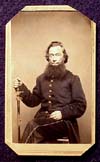
Click to Enlarge |
This wise old Regimental Surgeon reminds me of the Cowardly Lion from the Wizard of Oz!!! He proudly holds forth his Model 1840 Medical Sword. Image was taken by a New York "Bowery" photographer. Surgeons were commissioned officers who staffed field hospitals and the wards of bigger hospitals in large cities. Usually, each regiment had its own Field Surgeon. These men had male orderlies or "hospital stewards" to assist them. Female nurses were not yet given much professional responsibility at that time, largely being assigned to change dressings, give poridge & water, tended to linens and comforted the sick men. There were also visits from chaplains and volunteer groups for emotional support. During the Civil War, the Regimental Surgeons did NOT have M.D. or a red cross on their garb. They had insignia on their kepis, shoulder boards and swords which read "M.S." for Medical Staff. Stewards has green armbands with the snake & staff or cadeusis.
Tintype Soldier with Scratched Out Mother in Law
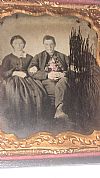
Click to Enlarge |
Gartin/ Read Family Photo Album with KIA Union & Southern

Click to Enlarge |
This is young Cumberland Gartin posing for a 1/4 plate ambrotype. The table upon which he rests his forearm hold a book (likely a bible) and his slouch hat. This young lad joined the 13th Iowa Infantry on 10/28/61, was wounded 7/22/64 at Atlanta, and disappeared near Columbia, South Carolina on 2/19/65 after Sherman torched the city. Interestingly, a true descendant of the Gartin-Read line recently contacted us and shared the exact family tree of Cumberland and his relatives up-unto the present day! This descendant was thrilled to obtain copies of the family album pictures along with associated ID's of their long-known descendants... Is it not strange how clues and info can still come-together even after 130 years!!!
Glass Lantern Slide of Union Civil War Encampment

Click to Enlarge |
This is a postwar lantern slide that was probably used in lectures, veterans demonstrations or schools during the Victorian Period. It would be slid into a slot in a flame-lighted lantern which then could be focused upon a wall or screen for lectures. A Civil War period image of a Union encampment was used to make this slide. You can see an American (Union) flag fluttering over the assembly of pointed Sibley tents. This item comes from a set of images depicting soldiers on guard, in trenches, beside cannon, etc. The wood frame is 7" x 4" and seems to be made of mahogany. A steel ring is inset to a depressed recess where the glass plate is held. This is an actual camp from whence men might have proceeded into mortal combat. We are fortunate that the camera had been invented prior to the Civil War, lest all these images be lost with the memory of veterans. Too bad there was no photography at the time of our own Revolutionary War!
Oval Tintype of Samuel Claar, WV 2nd Cav, died in service

Click to Enlarge |
This tintype was found in an old velvet lined necklace box with a typed note, stating that this image is of Samuel Claar, who was killed in action during the war and brought home to be buried at Four Mile Cemetary. And according to official archives, Samuel Clarr was in Co. H of the West Virginia 2nd Cavalry, and died of disease on 4/10/64 at Charleston, WVa. Samuel Claar is buried in Four Mile Cemetery in Jackson, Ohio. (Gravestone: http://ohiogravestones.org/view.php?id=69279).
Neat Ambrotype of Nearly-Identified Cavalryman

Click to Enlarge |
A neat 1/9th plate ambrotype with hazy solorization shows the peering image of a bearded cavalryman holding his saber stiffly. His slouch hat bears the larger 3 1/2 inched crossed-sabers insignia of a Union cavalryman as his jacket-style attests. Ambrotypes are set upon pieces of glass with a backing of black paint or velvet to give the dark contrasts behind the emulsion pane. However,the brass mats sometimes caused the chemical reaction or iridescent, hazy "solarization" where they contacted the image plate. Therefore, this aging process tends to creep in from the edges as we see in this image. An old paper tag that had been affixed to the rear contrast paint has fallen away. But sadly, it took away much of the soldier's name which had been written there. We often find names written on backs of old photographic images or hidden on notes behind them. When a full ID is present, it's a stroke of luck. But in this case, I suppose that we shall never really know who this man was, but you can be sure by his looks, he was certainly a real scrapper!
Tintype of Bearded Private in a Hardee Hat

Click to Enlarge |
The men of the famous Iron Brigade worn stiff Hardee Hats like these. You can see the Jeff Davis badge on the turnedup side and part of his infantry horn device showing over the front brim. With a loop, the Eagles on the buttons are clear. Focus and contrast are very good. He's a bit cross-eyed but a nice looking sincere fellow. Some small emulsion nicks to background.
CDV of Confederate Captain Geo. Smithy

Click to Enlarge |
This CDV shows a Confederate Captain, as evidenced by his collar bars. On the back in pencil is written only "Geo. Smithy" The imagte is faded and the face highly distorted. Parts of the hair and eyes appear drawn in with pencil. Perhaps it is a post-mortum image in which destroyed or decayed features were filled-in as needed. Bodies were often retrieved days and weeks after death, making the remains a bit unstable and unsightly. Add battle injury to the equation, such as a bullet taking off part of the face, and touching-up an image of a dead soldier was quite imperative. Photographs were not cheap for poor families, especially Southern farmers from rural areas. However, once a man was killed, the family had no other option but to purchase a "post mortem" photograph as a last-chance to recall their loved one before internment. We often see these images of the dead propped-up in caskets... This is likely the case with this CDV image. A mortally wounded Confederate Captain being immortalized as best possible before being laid to rest in hallowed ground. Wish we had more information on him...
John Hathaway mortally wounded Spotsylvania
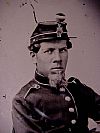
Click to Enlarge |
A ninth-plate tintype in full thermoplastic ("union") case of Pvt. John Hathaway, Co. K, 61st N.Y. Volunteers. Hathaway enlisted in April 1864, was wounded at Wilderness in May during the 2nd Corps assault on the Mule Shoe. John's grave is now located at Loudoun Park National Cemetery in Baltimore. His gravesite is Section A, site 93. He was born in Providence, R.I. and resided as a single gent in Newport, R.I. before his enlistment. Occupation: A hatter.
5 feet, 5 inches tall with a dark complexion, blue eyes & dark hair.
Casualty list No. 34 Index 50a shows him wounded at famed Battle of The Wilderness thereafter dying at 10 p.m. of June 22, 1864, aged 43. (After only 1 month in the service!) He was interred at 2 p.m. on June 23, 1864. Had been treated at The Newton University hospital in Baltimore. Records indicate that his personal effect included:
=1 knapsack
=1 pair of shoes
=1 blouse
=1 woolen blanket
=1 shelter tent
=Cash $180
Effects turned over to sister June 28, 1864. A great image of a man who died as a result of a famed Civil War battle. MY thanks to John Banks of Texas for this research!!!
General Meade War Period Autographed CDV
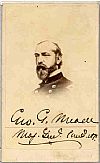
Click to Enlarge |
A Civil War period autographed CDV of Union "commanding" General George Meade. In charge upon the field of Gettysburg in the critical 2nd and 3rd Days. No backmark. Some minor lifting abrasions to backside when removed from old CDV album. Generals often were asked for signed photographs of themselves by friends, colleagues and fellow soldiers. Ones of the more famous officers and generals are now quite collectible. The Confederate images are less common and generally much more expensive.
Tintype of Friends: Did they Survive???

Click to Enlarge |
It is hard to look upon images of good friends who posed together during the Civil War without soon wondering who they were and if they survived? So often families were left with only a single tin photographic sheet by which to recall a lost warrior. The hardest part is seeing the warm and friendly soul within the imprinted faces of these troopers of BOTH armies. As children, brothers, husbands and fathers, how could they clash to kill and maim one another? It is simply a clear example of what occurs when good men abandon talk, compromise and higher-reason to push their prejudices, self-interests and narrow agendas at a cost of their otherwise united humanity. BOTH sides in war are a bit mad and gone wrong
Magic Lantern Slide

Click to Enlarge |
Magic Lanterns were used in the latter half of the Nineteenth Century to project photographic images across a room or lecture hall onto a screen, wall or backdrop. They were popular in lectures, universities and public talks. A photograph on a clear background was housed in a wooden frame and then slid into the tin lantern. Light from a kerosene lamp (later electric bulbs) would project the image through a lens onto the viewing surface. Entire sets of these slides could present a series of images on any desired topic. For fifty years after the Civil War, old Vets and their kin were intensely interested in hearing dissertations on the War, it's battles, strategies and politics. This lantern slide survives those days. It shows the reconciliation of old enemies over a proud Union flag.
Prisoners of War ~ Not always so lucky...

Click to Enlarge |
In any war, surrendering troops are not necessarily better off than those who have been killed or maimed. For some, there is starvation, disease, uncertainty and mistreatment. Many of us have heard the horror stories of Andersonville Prison where many Union troops died of famine and disease... In fact, the Commandant of that prison, Colonel Weir, was tried and executed after the war for his crimes against humanity. But a prison was no place to be on either side. Food was scarce, supplies slim and protection from the elements Spartan. While many withered away, others made gallant escapes and thousands of others were traded in "prisoner exchange programs." This picture shows the physical decimation of two soldiers who barely survived a harsh Civil War prison to the end of the hostilities.
Photographic Studios Flouish

Click to Enlarge |
During the Civil War, the studios of established photographers flourished as troopers rushed to preserve their own images for family members before marching away to uncertain fields of battle. So too, their sweethearts & kin back home took pictures of wives, siblings and children to give as treasured visual keepsakes for soldiers who were often homesick while wracked by illness and threat of imminent danger for weeks, months, even long years away from the homestead. Years later, these images might be the only trace of faces too soon disappeared to the grave... Fortunately, such images could be carefully copied and reproduced later by post-War studio artists when necessary. These proud early photographers considered themselves both craftsmen and chemical scientists all rolled into one. The long time-exposures and delicate chemical baths required to make a sharp image dictated that photographers be real exacting artists of their trade. As such, they usually marked the backs of their photographic mountcards with their names and addresses to revel in their success and advertise. In this case shown, the "Southern Photographic Temple of Art" at 213 Baltimore Street, Baltimore displayed an ornate lithographic image of the tools of the trade.
Another Man Taken to Heaven???

Click to Enlarge |
When a soldier did not return from war, the bereft family members often scrambled to find lasting momentos such as letters, possessions and photographs to preserve their memory of him. As today, most relatives do not believe that their loved-one will not return from war... And as such, sometimes just one small photo might be available for the entire family to tenderly share for decades after... In the years during and just after the Civil War, industrious photographers made copies of images by photographing the original picture itself. Thus, all family members could get a copy, which could even be "enlarged" to some extent before it blurred... In this case, we see a tiny "gem-sixed" tintype of a bearded Union private tacked to a studio wall whereupon it was carefully photographed to make a CDV (albumin paper) copy... Did this man die of disease; succumb to horrible wounds in battle; or simply want more images in his old age as a venerable GAR veteran??? We shall never know...
CDV of Colonel Shaw of Glory
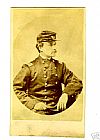
Click to Enlarge |
This is an early Civil War period CDV of the famous young Union Colonel, Robert Gould Shaw. A highly educated young fellow who lived a charmed & aristocratic life in New England, he joined the army by conviction towards the Union cause and anti-slavery. Rather than choosing some "elite" or easy desk assignment, he chose to lead a Union regiment made-up entirely of black soldiers. This was very atypical and controversial at the time. Though the typical white Union soldier supposedly fought against slavery, they did not believe in the abilities of freed slaves to fight. Colonel Shaw knew otherwise. He enlisted in the 54th Massachusetts Regiment and became its Colonel in April, 1863. He was killed three months later at the futile & desperate attack upon the heavily defended Confederate Fort Wagner (Confederate Battery Wagner) on July 18, 1863. He marched into a deadly hail of lead and cannonshot alongside his regiment of brave, orderly, regal freedmen. Afterward, he was buried by the rebels in a mass grave with his silent black troopers. The stunning movie "Glory!" was based upon these events of his and other brave patriots'lives. Academy Awards were given for these film performances. (Go rent & watch it now!)
Imprint on verso, "Whipple, 96 Washington Street, Boston" (scan below). Research dates this photograph from May, 1863.
CDV shows Colonel Shaw seated, wearing a cap and Colonels' double-breasted frock coat. His left arm is resting on a table, his right hand placed on his thigh. In his closed right hand are his gloves. A ring is worn on the pinky finger of his relaxed left hand (close up scan below).
This CDV recently sold on Ebay for over $3000... but the strength and dedication of this man toward freedom and human equity is forever worth well-over $1 Billion...
Riding Off into the Sunset

Click to Enlarge |
With no individual mechanized vehicles as yet invented, the horse was the sole improved mode of transporatation over the foot in the brogan or boot! The cavalry was a huge and awesome force in each army during the Civil War. Many cavalrymen had a reckless, more daring and somewhat flam,boyant nature. But decor and good looks quickly faded when steel and lead clashed in brutal deadly charges of huge mounted forces... Then it was time to ride to either victory or into oblivion!
Sailor Lad from Wooden Warship or Ironclad???

Click to Enlarge |
This is a Civil War period CDV showing a pensive, good-looking lad who is clearly a military sailor. He gazes steadfastly into the camera while resting his forearm on a table that holds a bible. His shirt, broad collar and scarf are hand-tinted in light blue. The back of the cardboard mountcard advertizes the photographer as: Paul Tralles, 1013 Pa. Ave. Washington, D.C. According to a pencil notation on the back, this interesting image came from the "Schoenborn Family Album" but does not mention city or state of residence. Images of young sailors are less common than ground troops. And rarely are they so intimate and relaxed in their aura as this image of an easy-going young man. Contrast & clarity are very good. Did he run the splintering decks of an old wooden warship during blockade or test the hot insides of a new-fangled monitor ironclad? Think of what he saw on the seas during that war!
Wood mounted Lantern slide: Death General Lyons

Click to Enlarge |
A very colorful and dramatic Victorian period magic lantern slide showing General Lyons being mortally wounded in the heat of battle. Three inch image window set in walnut frame. Labeled "Death of General Lyons" Traces of manufacturer's label remain along one edge of wood. Colors are still great and the glass not broken.
Colorful Young Zou!

Click to Enlarge |
"Zou Zou Zou!" they chanted as they charged. In their highly ornate & colorful outfits that mimicked the French Zouaves, these men were not hard to see on a battlefield. At first the subject of some stifled ridicule by rough & tumble Southern forces, they were typically proud and determined regiments that fought hard and daringly. In this CDV image, the photographer has taken the time to overpaint the colors of the uniform onto the albumin's paper. Since the Civil War, armies have opted instead for camoflague to blend-in with the surroundings. Not so for the Zouaves who preferred to be noticed, even if it was more likely to attract the attention of an enemy bullet!
Into the fray on a stead!

Click to Enlarge |
The size of Union and Confederate cavalry forces during the Civil War was huge! Yet few photographers ventured outside their studios to capture images of troopers mounted upon their trusty steads. The exposure times required still subjects and horses rarely listened to their pleadings of "smile for the birdie!" On top of the long shutter times, light could easily burn out or dim an image due to the fugitive chemicals involved in the process of early photography. A studio with controlled natural ceiling lighting and the subject's head clamped by a hidden stand from behind was much more predictable than chasing a snorting horse out in the mud. Thus, such outdoor mounted cavalry pictures from the Civil war are relatively uncommon. So even scratched, this image would be cherished by most all collectors these days!
Rare 1/4 Plate Tintype of CW Tents in 1863 Virginia

Click to Enlarge |
Outdoor photographic images from, the Civil War are very rare due to lighting and still-motion issues. Therefore, this is a quite uncommon 1/4-Plate tintype of a Civil War field encampment out upon flat farmland near two buildings. We see about ten of the very small two-man "pup tents" that were used by Union enlistedmen positioned on either side of a road. They kept rain mostly off the fellows, although their legs stuck out the back. Fields of similar tents housed the mortally wounded after battles like Gettysburg... This tin plate has "Virginia 1863" scratched into the rim emulsion under the front brass matting. It also has an orange two-cent revenue stamp with an 1863 hand cancellation, including the photographer's initials "S.C.J." (I invite you do the detective work on that one...) The contrast is a bit dark and focus (clarity) fine.
Ambrotype Images on Glass Plates

Click to Enlarge |
The very first photographs were produced on plates of thick "silvered" copper... making it an expensive and difficult process.
Then the next step in photographic technology, The Ambrotypes, evolved. The image emulsion was set upon actual panes of glass in a kind of reverse light-dark image. A black backdrop of pain, velvet cloth or painted tin was put behind the glass image to contrast it to the eye of the viewer. These Ambrotypes had quite excellent detail and focus. Only with the advent of the cheaper and more durable tintype were they replaced as the main method of taking photographic images. Many earlier Civil War troop images are Ambrotypes while most at the end of the war are tintypes. In this picture we see the glass plate offset from its black tin backdrop... thus looking like a ghost image until the black backing is put directly behind it.
When Ambrotypes start Flaking Away...

Click to Enlarge |
If one collects enough Civil War period images, you will no doubt get some "ambrotypes" as well. In that method of preserving images, the emulsion was set and developed directly on a glass plate rather than tin or the later papers. However, the visual image is reversed, so that a backdrop of black colored material is required behind the glass plate to show the image to our eyes. In the Civil War period, a thick syrupy black colloid was painted onto the opposite side (back) of the glass plate. Thus, the image was on one side, while the black paint was put on the other. Over the years, that black paint lifts and flakes away, leaving irregular visual "holes" in the image that we see. And yet, the true emulsion or picture is really still fully intact on the otherside of the plate! By replacing the black paint or filling-in just the flaked off areas, the image appears to be fully intact again! Using a black gloss "model paint" works the best. And yet, it does not damage or alter the original Civil War image (emulsion) on the other side of the plate. Our "new" paint backdrop could easily be scraped off of the glass in the future if one ever wished to use the exact same black colloid-syrup as during the Civil War for some reason.
1864 Union Camp of Sheds outside Decatur, GA.

Click to Enlarge |
THIS IS A RARE, VINTAGE 1864 CDV THAT SHOWS THE SHEDS AND FENCES OF A UNION ENCAMPMENT OF THE 32nd WISCONSIN AND THE 25TH INDIANA WITHIN THE FORT AT DECATUR, ALABAMA ALONG WITH OTHER COMPANIES OF THE REGIMENT. ON THE FRONT AT THE BOTTOM IS WRITTEN: "Taken from the top of a house looking North down the river". ON THE FRONT AT THE TOP EDGE IS WRITTEN: "The tents are the Camp 32nd Wisconsin". ON THE LEFT SIDE EDGE IS WRITTEN: "Camp 25th Ind V.Vet May 15th 1864 in the Fort at Decatur, Ala." ON THE REVERSE IS WRITTEN: "At the top of the Card presents the wood in distance about 3/4 miles. The low black shrubbery is the hedge fence on either side of the Courtland Road. The line of stakes is the line of Breast works-the shanties that are covered with tents, is the camp of the 32nd Wisconsin. Next to that comes Co A of our Reg. then all the other Companies from left to right, the second shanty from "G" is the one our Mess stayed in, the long shed at the right end of our quarters is the shed we eat under. The dark shady look place is the garden between the hospital at the railing".
A Brass Picture Locket from Harsh Fredericksburg

Click to Enlarge |
This is a sweet little brass picture locket that opens to house two images. It has pretty designs on outside. It comes from the battle zone of Fredericksburg. The tintypes which were housed across from each other have rotted away underground long ago. But the locket remains for us still. A testiment of men at war who still cherish the soul of family even as they face and deal-out death! What rembling fingers looked upon faces of dear ones for a last time before lifting musket and marching into lead and cannister? This idea tears at one's heart even to this day! If only the locket could speak! Tell us what became of the man. Why did he lose it in battle? Why would anyone lose such a thing unless he were killed or maimed? We can only image... Bullets and shells rain but the heart aches to be back home one last time. Size each side: About 3/4" by 1/2". Still has loop to attach to a chain or fob area. Found on Pierson Farm circa 1885.
Armed to the Teeth for Upcoming Battles!
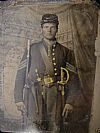
Click to Enlarge |
Just look at this young Union sergeant in the photograph! He is carrying every possible weapon! A musket, a holstered revolver, an NCO sword and even a fighting knife in his belt. Men also carried "extra" weapons such as brass knuckles, boot pistols and shotguns for the cavalry!
Wisconscin Tintype in Hardee Hat Great Coat
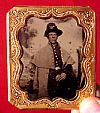
Click to Enlarge |
This is a very nice 1/6-th plate Civil War period tintype of a Union trooper in a great coat and Hardee Hat that came with group of Wisconsin letters. The infantry horn, regimental numbers "28" and ostrich plume are seen. Also his belt buckle and buttons are gold tinted. Has pink tint to cheeks. Stands before a canvas backdrop of a terraced garden.
Nicholas Cage Look-alike Ambrotype smoking Cigar Smoker

Click to Enlarge |
Steely Eyed Union Troop Armed with Musket
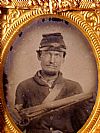
Click to Enlarge |
This is an early CW 1/9-th plate glass ambrotype image of a steely-eyed Union private. He wears a kepi and sports a US belt plate. He holds an older musket across his chest, thumb at hammer. No ID known.
Tintype of Rediscovered Union Warrior from Michigan

Click to Enlarge |
This is a cool 1/9-plate tintype of a cool, calm, collected Union private. He looks so relaxed and amiable. Behind the image is a piece of paper from an old collector, telling story of how/where he bought this image. He "deduced" who the soldier in the image was from word-of-mouth descendant facts: "William Washburn." In fact, the old collector was correct. In checking Civil War Database, I found William Washburn who enlisted at Hillsdale, MI as a private at age 30 on 8/30/1862 in 4th Michigan Infantry Regt. Wow! It is so darned cool to "resurrect" a man's life like this... The image now has a true soul.
Ambro of Faceless Union Musician with Pistols
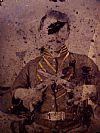
Click to Enlarge |
This is a cool 1/6-th Plate ambrotype of a Union musician with two pistols linked acriss his fancy chest piping on uniform. He wears an NCO belt plate. Someone tried to clean emulsion in past and rubbed off his eyes. No ID known.
Ambrotype of Most-Daring Lovers
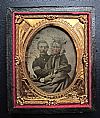
Click to Enlarge |
This is a 1/9-th glass plate Ambrotype of a dapper Union corporal holding his sweetheart on his lap! This is an amazingly bold image for the Civil War era. Either these two lovers were way ahead of the common rules, or perhaps she was one of the "Dutch entertainers" who kept up "morale" of the Union troopers on leave in Washington. Wish I knew the whole story!
CDV 79 NY Colonel Killed Bull Run
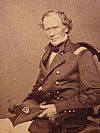
Click to Enlarge |
This is James C. Cameron a 60 year old lawyer who was killed on 7/21/1861 at Bull Run, VA. One of the highest ranking officers KIA that day. Taken by Brady in Washington, this CDV shows a wise man seated in his frock coat with officer shoulder boards. He holds his early war Hardee hat with embroidered eagle insignia.
Unusual Two Officer CDV
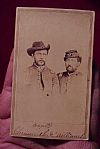
Click to Enlarge |
Most CDV photographs were of individuals. Unless a married couple posing, it is unusual to see pairs of soldiers posed in this way. These men are labeled in ink under the image as "Capts" Absalom Chenoweth and Thomas Jefferson Williams of the 56 th Ohio Infantry. They must have been friends as well as military comrads.
CDV of George Soule with comrad in New Orleans
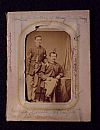
Click to Enlarge |
This is a nice Civil War era CDV of two alert-looking Union troopers. It is still housed in its photo album page to preserve family inscriptions about Soule. There is an "X" over the seated private's head, indicating it is the George Soule mentioned in margins of album page. One notation says "unmarried~ died in west", but unclear if died in war or later of natural causes. The standing soldier is a corporal and rests his arm amiably on Soule's shoulder. The photo carries a New Orleans backmark. Therefore anyone thought to be Soule during research must have been stationed in NO briefly. There are a number of George Soules in the Civil War database. Only one died in war, but his regiment did not reach NO by the time that Soule died in 1861. This photo warrants more research. From margin we know that George was the brother of Mary (Soule) Hoag, so a good genealogy buff can track down the exact man. A nice image.
Tintype of a determined Union Drummer

Click to Enlarge |
This is a tintype photograph of a determined-looking Union drummer. He holds his sticks before him. Sadly, wooden sticks did not stop bullets!
Amazing Tintype of Fully decked Out Young warrior

Click to Enlarge |
This is an amazing tintype of a young Union Warrior in full regalia. Slouch hat with crossed-sabers insignia, a kepi number 5, pre-War cavalry saber and gold toned uniform piping! Plus, he is smoking a cigar! What a wonderful image! Permission given by the current owner to add this to our Cyber Museum.
Two Tintypes of Union Comrads in Company D

Click to Enlarge |
This is an ornate hard gutta percha case which contained two 1/9-th plate tintypes of Union privates. They likely are friends or relatives since both their kepis bear the same Company "D" insignia. Sadly, no names written in this case. Glass and brass mats are original.
Union Female Spy Harriet Wood aka Pauline Cushman
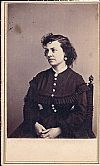
Click to Enlarge |
This is a CDV of the celebrated Union lady spy: Pauline Cushman (born Harriet Wood. In 1851 she joined a performance group in her native state: The New Orleans Varieties. Later she would travel to New York where she would take the stage name Pauline Cushman. After a Northern performance, Pauline was paid by two local pro-Confederate men to toast Confederate President Jefferson Davis after a performance. The theatre fired her, but she had other ideas. She had decided to ingratiate herself with the rebels by making the toast, while offering her services to the Union as a spy. By fraternizing with rebel military commanders, she managed to conceal battle plans and drawings in her shoes, but was caught and brought before Confederate general Braxton Bragg, tried by a military court, and sentenced to death. It is said that she was saved three days before her hanging by the invasion of the area by Union troops. Some reports state that she returned to the South in her role as a spy dressed in male uniform for references. She was awarded the rank of Brevet Major by General James A. Garfield and commended by President Abraham Lincoln for her service to the Federal cause, and became known as "Miss Major" Fat Cushman. By the end of the war in 1865 she was touring the country giving lectures on her exploits as a spy.
Using fancy Old Frames to Display Photographs
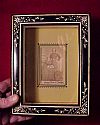
Click to Enlarge |
During the Civil War period, images were kept either in small cases or albums. There were very few wall frames for images. Later, as the Veterans aged and bought big Victorian houses, they wanted to proudly display their war service images. Photographs were retro-fitted into fancy frames for their parlors, libraries and hallways. Using old frames to house CW images can be great, as long as you don't damage them with mats, glue, adhesives. Light can also fade old images, so hang them in a darker section of your home. This image is a CDV of an officer with his wife now housed in an ornate Victorian Eastlake Style shadowbox frame.
Great Sixteenth Plate Tin Tricorner insignia hat
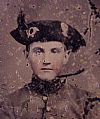
Click to Enlarge |
This is a sixteenth plate tintype of a young Union soldier. He wears an unusual tricorner hat adorned with infantry hunting horn, ostrich plume, and Hardee Hat badge! About 1 1/4" by 1 1/2". It was said to be from "either" Ohio or New England. A neat variant piece of headgear!
Ruby Ambrotype of Union private and two sisters

Click to Enlarge |
What could speak to the bitter poignancy of the Civil War better than a young lad who is going off to battle posing beside his two sisters. The girls look like deer caught in the headlights as they try to wrap their minds around what fate might do... This sixth-plate ruby glass ambrotype is still housed in its original face glass, brass mats and full leatherette case. Sadly, no ID known to these sitters.
Till Death Do Us Part
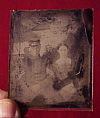
Click to Enlarge |
This is an eerie Civil War glass plate ambrotype of a serious-looking Union Corporal with makeshift chevrons posing beside his stark farm wife. The fading and scrapes to the old photograph's emulsion give it a spooky "lost in time" mysterious look, as if we are being revisited by ghosts. In an age when divorce was rare, mostly illness and war could cleave a young couple. If only we could know their true stories. They are only left lines etched in time now....
Union Soldier Tintype in Oreo Gutta Percha Case
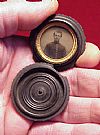
Click to Enlarge |
This is a small tintype of a uniformed Union soldier housed inside a fancy round gutta percha hard-case known as an "Oreo case" because it looks a bit like the cookie. About 1 3/4" across case. These cases are highly sought after these days!
Poignant Ambrotype of Union soldier and his son
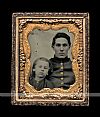
Click to Enlarge |
This is a very poignant Ninth-Plate Ruby Glass Ambrotype from earlier in Civil War. It shows a young Union private with his son. As usual, the detail and depth of ambrotypes are often astonishing. Many children never saw their fathers again in both North & South. Photo copy donated to museum by Jack Mord.
Young Troop Inspiring Nude Greek Woman CDV
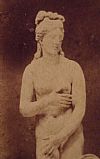
Click to Enlarge |
This is a CW era CDV card showing a Classic Greek or Roman marble statue of a nude young woman. At the time of the Civil War, there was not yet much true nude photography to stimulate young men. However, classic paintings, engravings and museum statues did the trick. You carry a picture of your gal, your mom, and your nude Goddess into battle!
Young Soldier father and his Lovely Daughter
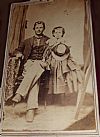
Click to Enlarge |
This young lady is posed with her soldier father. She is dressed in her Sunday best. Very poignant. Imagine her feelings if Daddy was hurt... A CDV. Our copy has no backmark or ID. Multiple cards exist.
Large Tintype of Asian descent Union Private
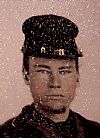
Click to Enlarge |
This is a quarter plate tintype of a Union private of definite Asian descent. Wears a pinky ring and a little goatee beard. No ID yet known. Quite interesting to see in Civil War photogra0ph!
Tintype Young Trooper with Sweetheart Lock Hair
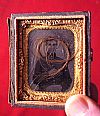
Click to Enlarge |
This is a Civil War era ninth-plate Tintype of a young, scrappy Union private seated with his hand over his heart. Dedicating his life on earth to the Union, or, to his imagined union with the girl he left behind at home to go to War? There is a small lock of strawberry-blonde hair under the glass over his image. Still locked in love after over 150 years! The image is minimally dark on contrast. Comes in a full leatherette ninth-plate case. Sadly, no sitter identification is known. An iconic combination of soldier and loving memento from his heartthrob left home who hoped to see his face on the horizon in 1865!
A CDV photo of wounded Union soldier L. Swain
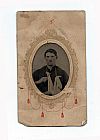
Click to Enlarge |
This is a CDV photograph of a wounded Union soldier in an arm sling. On back is what looks like his name, L. Swain. Very cool to see a soldier actually posing wounded. He must have been proud of how he sacrificed for his country.
Civilian Tintype of Two Hot Civil War Babes

Click to Enlarge |
Many folks presume that Civil War era women were all a bit plain or matronly in thick clothing with three kids on their lap. However, like today, women were quite stylish when their upbringing and lifestyles permitted. Some were downright supermodels of their day, and likely turned heads. In this tintype, we see two young women who anyone would admire for poise and great looks! Something more back home to fight for than the flag and a farm! No ID is known on the sitters. It came in its original glass, brass mats and a half of a leatherette case.
Ambrotype of Female Workers from Allegheny Arsenal

Click to Enlarge |
This is a large quarter-plate glass Ambrotype of a group of female Allegheny Arsenal workers from the Lawrenceville section of Pittsburgh, Pennsylvania. They wear similar uniform clothing and one may be their supervisor. It is unclear if any or all of these women were involved in the infamous accidental explosion at the arsenal that killed many workers on the same day as the Battle of Antietam, September 17, 1862. Another image that came with it was annotated "Aunt Pauline, killed at arsenal" so there is a real possibility.
Odd tintype of gypsy woman putting spells on enemy
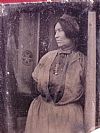
Click to Enlarge |
This is an odd tintype, about 1/9-th plate size. It shows a woman who seems to wear European clothes, with perhaps a carved wagon door beside her. Is she an old Gypsy??? Slightly dark. Very interesting!
Ambrotype of an angry African American Soldier
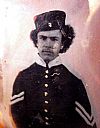
Click to Enlarge |
This is an original 1/9-th glass plate ambrotype of a very angry looking African American. (Do you blame him?) His facial features and Afro-style hair say his was a black man. The uniform is a bit unique with white collar and stovepipe-like military hat. But his corporal chevrons seem to be of CW era. In fact, ambrotypes fall exactly into the start of the Civil War era. Was he early black unit given an odd mix of left-over uniforms, or possibly enlisted into the CSA guard as military servant. I could not say. But a quite unique hard image. Photos of CW blacks in uniform are hard to acquire.
Ambrotype troop in custom Philapdelphia wall case
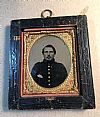
Click to Enlarge |
This is an original sixth-plate glass ambrotype of a startled-looking soldier in a shell jacket with shoulder tabs. Inside the frame is a paper ad explaining ambrotypes from Philadelphia photographer "I. Rehn, 126 Arch Street" It is most interesting to see how paper advertisements explained the current technique of photography on glass plates....
3 Military & Family Images: Allen Jacobs Co A 34 Iowa

Click to Enlarge |
This is a wonderful set of 3 original CW era hard images of Pvt. Allen Jacobs & his Family. Jacobs served in Co. A of the 34th Iowa Volunteers. You can see the company A insignia and Regiment "34" on front of his kepi in his sixth-plate uniformed tintype. I obtained these from a serious collector who spent many careful hours of research on the soldier. The name Jacobs in written in rear of all the cases, verifying the Family name. He found that there were only (5) Jacobs total in all of the 34th Regiments of the Civil War including confederate and union states. Research was done on each of those regiments listed on the U.S. Park Service data base for Civil War Soldiers and there was only one 34th regiment, Co. A that listed a Jacobs on their roster. It was Iowa, Co. A, Pvt. Allen Jacobs. Thus, the identification! There are three sixth-plate sized images, two Tintypes and one earlier Ambrotype. These were all found together. #1 - Ambrotype. This image of Jacobs and his wife was likely taken just before the war. Some minor emulsion scratches. #2 - Tintype of Jacobs wife and two children ( The wife matches the woman in the Ambrotype with her husband Allen.) #3 - Tintype of Pvt. Allen Jacobs in his Union uniform(jacket and kepi)
Kepi has emblems attached to the front ( 34 & A). Inside the case backing is a handwritten signature "JACOBS" in pencil. All three images of this great set come together. It practically tells the immediate CW timeline of a Union soldier and his life left back home.
These all are the same family.
Amazing Tintype of a Union Musician Soldier with fife
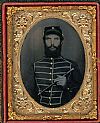
Click to Enlarge |
This is an original ninth-plate photograph of a Union trooper who is a uniformed musician. He hold a fife which is not a common instrument to be shown so clearly. His shell jacket has the butterfly type cross-chest piping worn by musicians. Excellent contrast and clarity. Sadly, his identity is still unknown. But more & more complex facial recognition programs that are linked to known CW soldier databases are starting to ID these troops if a picture already exists in files elsewhere. The use of this great image was offered by a friendly EBay seller who we thank!
Ambrotype Two 176 th PA troopers ~ one Died in War

Click to Enlarge |
This is an original Sixth-plate Ruby glass ambrotype of two enthusiastic Union recruits in kepis. They are obviously friends going off to fight for the Union together. Great clarity. Some minor swipes to emulsion. They are identified in back of case: William R. Wimmer and John Schleifer(on right). Both enlisted in Co. E of PA 176 regiment in November 1862. Their exact images shown on the Civil War Database confirms this. Sadly, John died at Hilton Head, SC on 2/5/1863. Possibly William mourned enough to not reenlist. He was mustered out on 8/8/1863 and went on to lead a long life in Allentown, PA. Belonged to GAR Post #87. Died 10/25/1930. Gosh! What he'd seen pass in that lifetime! This comes in a leatherette half case.
Cool CDV of Indian Wars Native American Scout
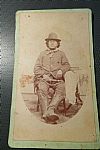
Click to Enlarge |
This is a cool original CDV of a Native American scout likely from the American South West during the Indian Wars era. He wears a sack coat, a slouch hat, neck scarf, pants with a stripe and tall boots for riding. He appears to be holding a whip! On back of card is likely his Nickname "Savi". I wish I knew his story!!! Some minor stains to card. No backmark.
|

